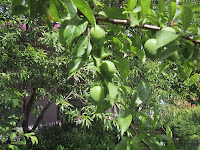A month later, and we have come to the time to thin our fruit here in Oregon. Thinning probably could have happened earlier, when the fruit was about grape size, but better late than never.
To review, we thin fruit to control size, quantity, and quality of the fruit on our trees. Apples and pears particularly need thinning as they will revert back to biannual bearing, or bear heavily one year and very sparsely the next. For consistent fruit set in pome fruits, we need to thin. Left unthinned, the fruit buds send messages via plant growth regulators, to reduce the blossoms for next year. Peaches are thinned to increase quality and size of fruit. If all the fruit is allowed to grow, you will get many small, disappointing fruit. Also with peaches, thinning fruit helps to alleviate branch breakage due to fruit overload. Plums are thinning optional, only if you enjoy large fruit and if you have problems with branch breaking.
Okay, enough with the words, hopefully the before and after pictures below will clarify thinning. The first set of pictures is an apple before and after thinning. You can see that with a heavy set, you can get five fruit in a cluster (one for each flower). Generally you thin to the biggest, healthiest apple which is usually the center of the cluster or 'King Blossom'. Don't ask me why its a king versus queen, its fruit. Simply cut off or snap off the surrounding fruit to one fruit per cluster. If you have several clusters of fruit on a limb, the remaining thinned apples should be at least 8-10 inches apart. Be sure to compost the thinned fruit, and not throw them on the ground as that will encourage pest problems. That is it. Though if you have a large tree, it can take some time.
For pears, it is the same process as for apples. The pictures below just happen to be Asian pears, but the same principles apply as with apples.
Finally, a stone fruit example. As I was hard pressed to find any peaches in our neck of the woods, a plum will suffice. As you can see, like the flowers, plums are anywhere along the stem and can hang in dense clusters. Dense clusters can create bug and disease problems, and is, come to think of it, another reason to thin plums. Anyway, its really just an option, as stone fruits can have overwhelmingly large amounts of fruit. Peaches would be thinned as you would apples, singling out clusters and leaving 8-10 inches between fruit on a branch.
There isn't a whole lot of visual difference with the plums, but thinning out doubles and extra heavy branches is a good idea.
After thinning, your fruit tree is ready to give its resources to the remaining fruit, including water. Watering over the summer on a regular basis will ensure minimal fruit drop, larger fruit, and vigorous trees. I will talk more about watering next time.
After thinning of apples, it is wise to protect your apples against the number one pest of apples, coddling moth. That is the moth that lays an egg near the stem, the larvae bores a hole to the core of the apple, eats the seeds, then reemerges through a different hole. The 'worm in the apple' worm. If you have ever cut open an apple to find a worm smiling back at you, that is a coddling moth larvae. To protect your apples without chemicals, you can 1. spray them with kaolin clay, which is expensive and doesn't really work, 2. bag your apples with little baggies or stocking type material which works, but is labor intensive and it also looks a little goofy, or 3. don't do anything at all and deal with the moths and their larvae. There are also traps available which work fairly well, are a tad expensive, but less labor intensive as bagging. Its up to you and how much work you want to do.
I will talk more later about watering and pests/diseases. The two are more linked than they first seem?!
Enjoy the sunshine!





